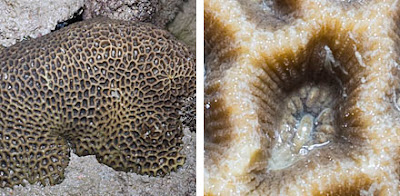Just 15 minutes from the main business district lies the tranquil beaches of Little Sisters Island.
It's our first trip here in 9 months! I have finally started trying to write a new series of guide books for our shores! And I realise I need much better closeups of common marine life. While the rest explored more exciting parts of Little Sisters, I settled down to look at ordinary stuff.
In a tiny hole in a large Pore coral (Porites sp.), I saw something that might be a claw. I have no idea what is going on!
Hard corals are identified by small features. And I realise I haven't been taking good photos of them! Here's the commonly seen Zebra coral (Oulastrea crispata) which has white corallites on a black background.
Here's some of the close ups I took yesterday. Coral colonies that appear smooth, actually have tiny corallites and tiny polyps.
It's amazing how coral colonies that look similar at first glance can have quite different shaped corallites when we look more closely.
Some hard corals have polyps that look like tiny sea anemones! I'm still not satisfied with the photos I took and will have to try harder to get better shots of these tiny features.
Another fascinating closer look, this time at the Black-and-white leathery soft coral (Cladiella sp.). Like other soft corals, it has branched tentacles. But the polyps are very very small!
I also took a closer look at Mermaid's fan seaweed (Padina sp.). I have read that this seaweed has concentric circles of little hairs but only managed to photograph it now!
I have often seen Twig-like halfbeaks (Family Hemiramphidae)on many of our shores. But this one had a more colourful pattern. There were of course, also lots of other fishes.
The only nudibranch I saw was a tiny Jorunna funebris which is quite commonly seen on many of our shores. The rest of the team saw lots of other slugs. Chay Hoon of course found some special ones.
On our trip, the reefs are covered in a golden carpet of Sargassum seaweed (Sargassum sp.)! This is normal for this time of the year, but it does make it difficult to explore the reef. We don't want to hurt any animals hiding under the seaweed or step on dangerous animals, so we avoid stepping on the carpet.
In some parts of the shore, though, the Sargassum seaweed seems to be losing their 'leaves'. Did something eat them?
The seaweeds are teeming with tiny critters of all kinds. I couldn't photograph them very well. This tiny brittle star has patterns! Which I couldn't see until I got home to process the photo.
There were also colourful sponges, big anemones (Chay Hoon found one with 'Nemos') and these clusters of pretty disk-shaped corallimorphs.
As the tide turned and we explored the high shore, we came across these pretty moon snails. They sure look like China moon snails (Natica onca), which so far I've only seen on Cyrene Reef.
Chay Hoon spotted this lovely deep purple Land hermit crab (Coenobita sp.) squashed into a tiny shell. Hermit crabs need empty shells to 'upgrade' into as they grow bigger. So please don't remove shells from the beach! A hermit crab may need it!
Thankfully, we had a rain-free trip! The rest of the team found feather stars and lots of other interesting sightings. I'm sure they will blog about it soon.
Posts by others about this trip























